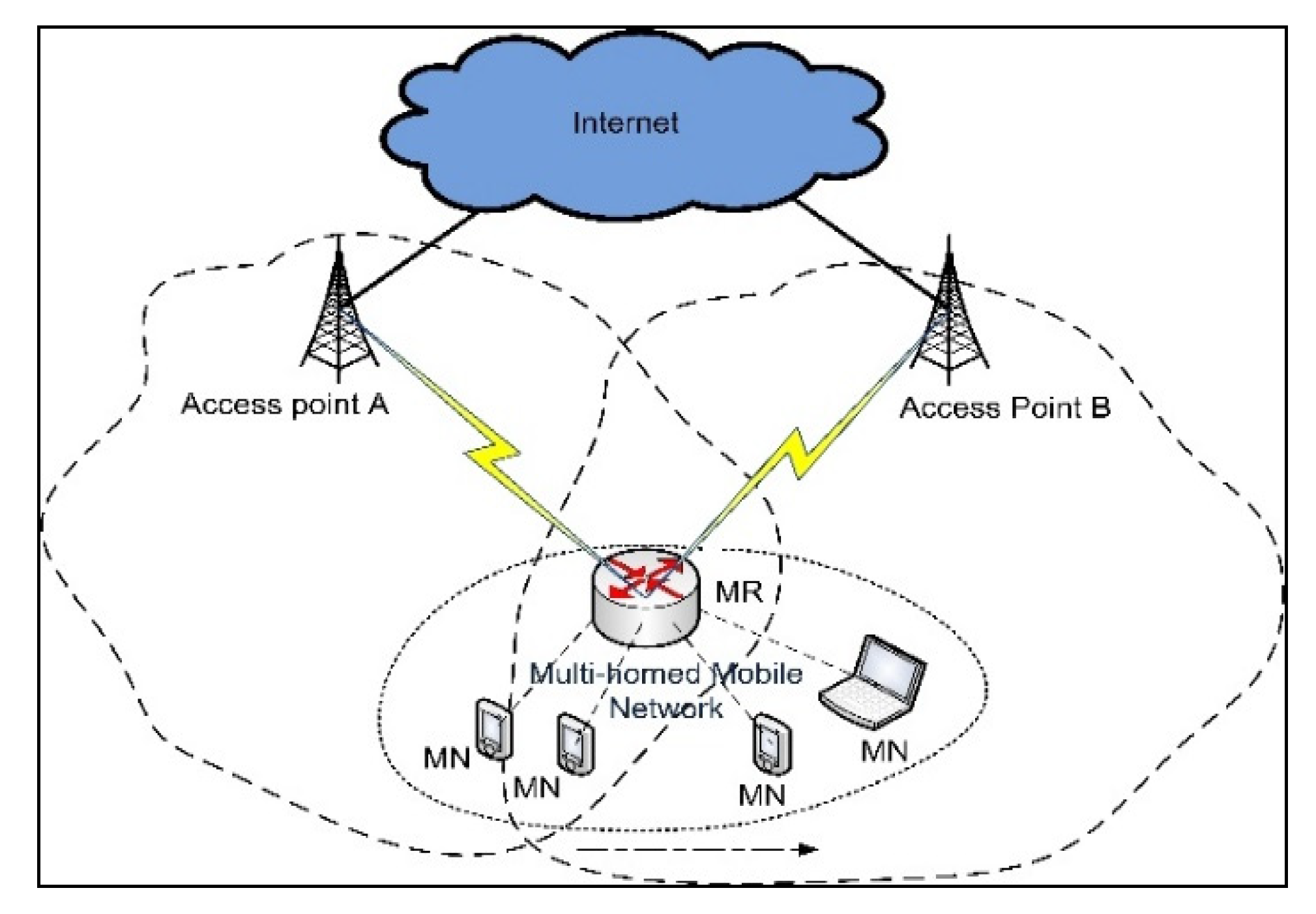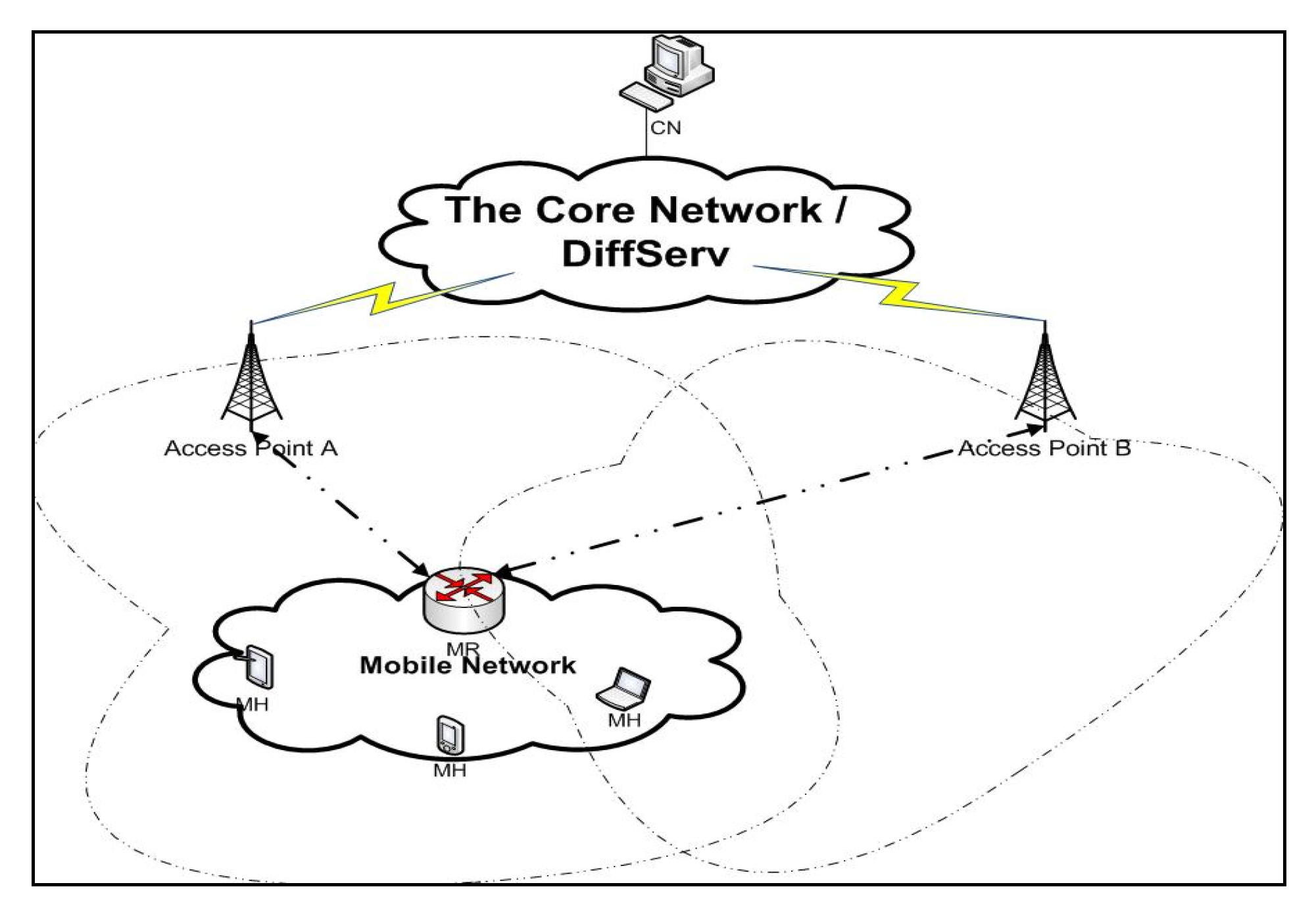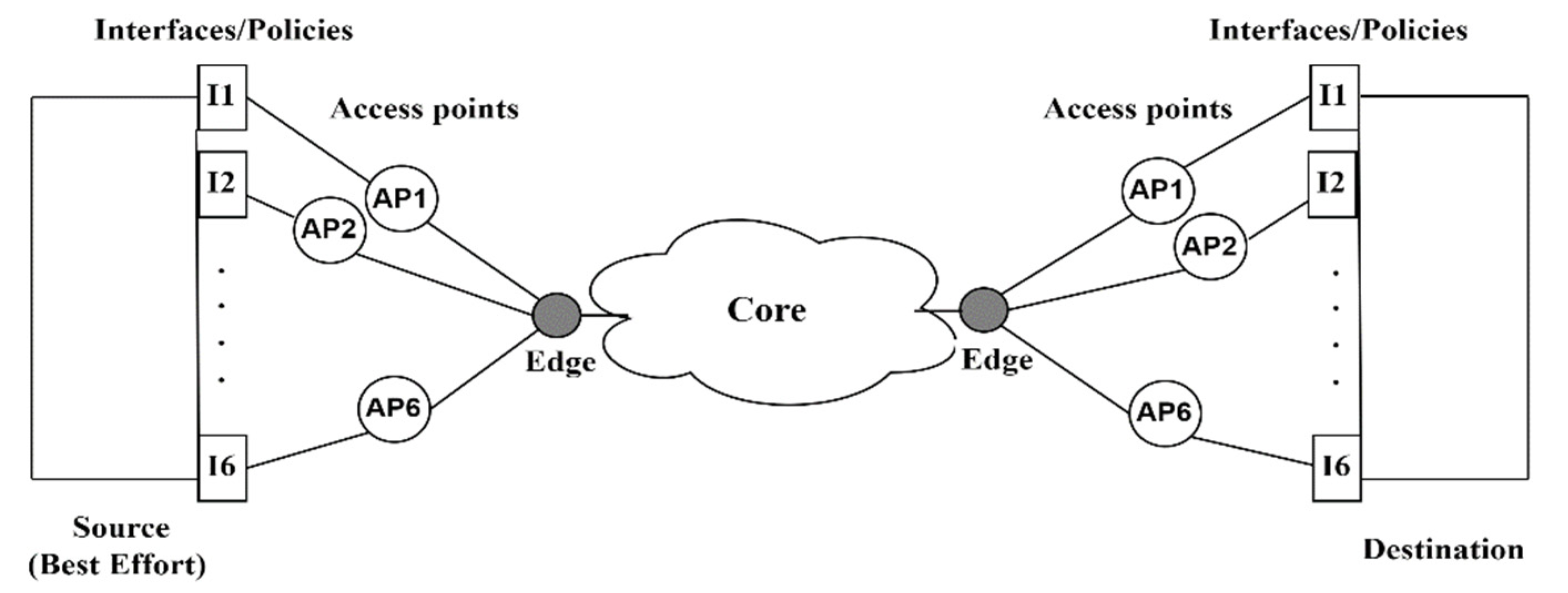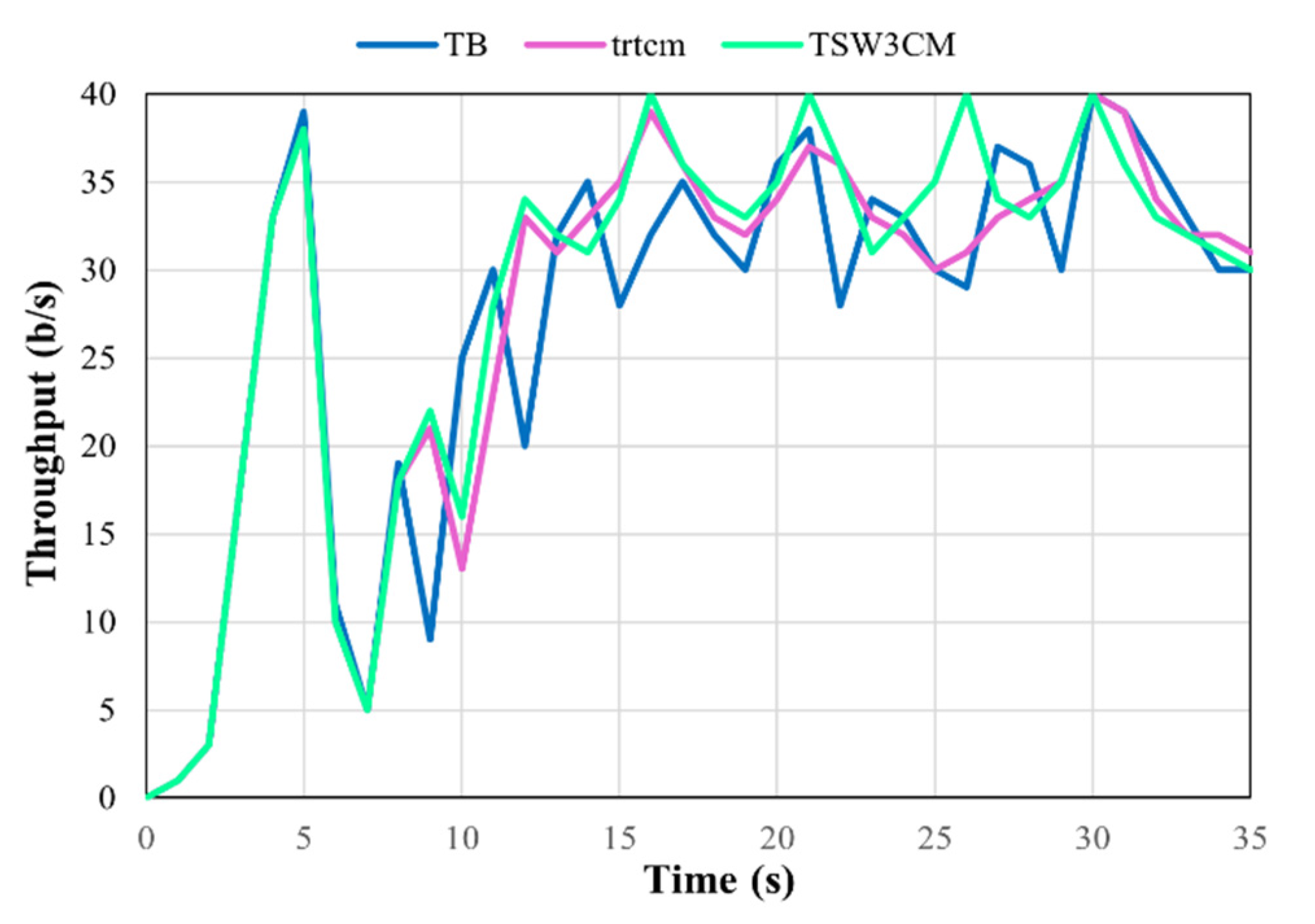Evaluation of Differentiated Services Policies in Multihomed Networks Based on an Interface-Selection Mechanism
Abstract
:1. Introduction
- The paper introduces a reliable system, supplying a sufficient solution for the associated end nodes (the mobile-service-demanding user serving equipment) during handovers.
- It presents a study of different DiffServ mechanism policies. It studied the effects of deploying each policy into various interfaces (the portals that connect nodes to the Internet network), and the increased overall network performance when nodes managed to switch between them (to acquire better performance necessarily) according to their availability.
- It studies the overall performance and feasibility of deploying several policies with the single-homed and multihomed networks/nodes (site and host multihoming) while the availability of resources was fluctuating. It compares the performance of the influential parameters.
2. Background
2.1. Multihoming
2.2. Differentiated Service (DiffServ)
2.2.1. DiffServ Architecture
- (1)
- Node positions
- (2)
- Traffic direction
2.2.2. DiffServ Mechanism
- (1)
- DiffServ service agreement
- (2)
- DiffServ Code Point
3. Methodology
- Time-Sliding Window with two-Color Marking (TSW2CM): A committed information rate (CIR) is used as well as a two-drop precedence. When the CIR is exceeded, the lesser priority is employed probabilistically.
- Time-Sliding Window with three-Color Marking (TSW3CM): CIR, peak information rate (PIR), and three-drop precedence are used in this method. When the CIR is exceeded, the medium drop precedence is adopted, and when the PIR is exceeded, the lowest drop precedence is adopted.
- Token Bucket (TB): Two-drop precedence is used with a CIR and committed burst size (CBS). If, and only if, an arriving packet is larger than the token bucket, it is given lower priority.
- Single-Rate Three-Color Marker (srtcm): To pick among the possible three-drop precedence options, the CIR, CBS, and excess burst size (EBS) are used.
- Two-Rate Three-Color Marker (trtcm): To pick among the possible three-drop precedence options, the CIR, CBS, PIR, and peak burst size (PBS) are used.
- Null does not degrade the quality.
4. Simulation Results
4.1. Setup
4.2. DiffServ Policies Investigation
4.2.1. Throughput of Generating Packets at CN
4.2.2. The End-to-End Latency and Processing Time in Intermediary Nodes
4.3. Investigation of the Best Three Policies (Multi-Interface)
4.3.1. Throughput of Generating Packets at CN
4.3.2. The End-to-End Latency and Processing Time in Intermediary Nodes
5. Conclusions
Author Contributions
Funding
Conflicts of Interest
References
- Oleiwi, H.W.; Al-Raweshidy, H. Cooperative SWIPT THz-NOMA/6G Performance Analysis. Electronics 2022, 11, 873. [Google Scholar] [CrossRef]
- Oleiwi, H.W.; Saeed, N.; Al-Raweshidy, H. Cooperative SWIPT MIMO-NOMA for Reliable THz 6G Communications. Network 2022, 2, 257–269. [Google Scholar] [CrossRef]
- Oleiwi, H.W.; Mhawi, D.N.; Al-Raweshidy, H. MLTs-ADCNs: Machine Learning Techniques for Anomaly Detection in Communication Networks. IEEE Access 2022, 10, 91006–91017. [Google Scholar] [CrossRef]
- Oleiwi, H.W.; Saeed, N.; Al-Raweshidy, H.S. A Cooperative SWIPT-Hybrid-NOMA Pairing Scheme considering SIC imperfection for THz Communications. In Proceedings of the 2022 4th Global Power, Energy and Communication Conference (GPECOM), Nevsehir, Turkey, 14–17 June 2022; pp. 638–643. [Google Scholar] [CrossRef]
- Oleiwi, H.W.; Al-Raweshidy, H. SWIPT-Pairing Mechanism for Channel-Aware Cooperative H-NOMA in 6G Terahertz Communications. Sensors 2022, 22, 6200. [Google Scholar] [CrossRef] [PubMed]
- El-Dessouki, I.; Saeed, N. Smart Grid Integration into Smart Cities. In Proceedings of the 2021 IEEE International Smart Cities Conference, ISC2 2021, Manchester, UK, 7–10 September 2021. [Google Scholar]
- Bosk, M.; Gajic, M.; Schwarzmann, S.; Lange, S.; Trivisonno, R.; Marquezan, C.; Zinner, T. Using 5G QoS Mechanisms to Achieve QoE-Aware Resource Allocation. In Proceedings of the 2021 17th International Conference on Network and Service Management: Smart Management for Future Networks and Services, CNSM 2021, Izmir, Turkey, 25–29 October 2021; pp. 283–291. [Google Scholar]
- Pesántez-Romero, I.S.; Pulla-Lojano, G.E.; Guerrero-Vásquez, L.F.; Coronel-González, E.J.; Ordoñez-Ordoñez, J.O.; Martinez-Ledesma, J.E. Performance Evaluation of Hybrid Queuing Algorithms for QoS Provision Based on DiffServ Architecture. In Proceedings of the Lecture Notes in Networks and Systems, Athens, Greece, 29–30 September 2022; Volume 216, pp. 333–345. [Google Scholar]
- Liu, R.; Sheng, M.; Wu, W. Energy-Efficient Resource Allocation for Heterogeneous Wireless Network with Multi-Homed User Equipments. IEEE Access 2018, 6, 14591–14601. [Google Scholar] [CrossRef]
- Costa, L.R.; Lima, F.R.M.; Silva, Y.C.B.; Cavalcanti, F.R.P. Radio resource allocation in multi-cell and multi-service mobile network based on QoS requirements. Comput. Commun. 2019, 135, 40–52. [Google Scholar] [CrossRef]
- Wang, X.; Jia, M.; Guo, Q.; Ho, I.W.H.; Wu, J. Joint Power, Original Bandwidth, and Detected Hole Bandwidth Allocation for Multi-Homing Heterogeneous Networks Based on Cognitive Radio. IEEE Trans. Veh. Technol. 2019, 68, 2777–2790. [Google Scholar] [CrossRef]
- Liu, J. Design and Implementation of Vo IPQoS Model Combining IntServ and DiffServ Based on Network Processor IXP2400. In Proceedings of the Proceedings-2021 7th Annual International Conference on Network and Information Systems for Computers, ICNISC 2021, Guiyang, China, 23–35 July 2021; pp. 60–64. [Google Scholar]
- Zhang, Z.; Wu, Y. Iterative rank-two transmit beamforming design for qos-diffserv multi-group multicasting systems. In Proceedings of the 2018 IEEE 4th International Conference on Computer and Communications, ICCC 2018, Chengdu, China, 7–10 December 2018; pp. 114–118. [Google Scholar]
- Gladisch, A.; Daher, R.; Tavangarian, D. Survey on mobility and multihoming in future internet. Wirel. Pers. Commun. 2014, 74, 45–81. [Google Scholar] [CrossRef]
- Toor, A.S.; Jain, A.K. A survey on wireless network simulators. Bull. Electr. Eng. Inform. 2017, 6, 62–69. [Google Scholar] [CrossRef]
- Gan Chaudhuri, S.; Kumar, C.S.; Rajakumar, R.V. Validation of a DiffServ based QoS model implementation for real-time traffic in a test bed. In Proceedings of the 2012 National Conference on Communications, NCC 2012, Kharagpur, India, 3–5 February 2012. [Google Scholar]
- Na, Z.; Liu, Y.; Shi, J.; Liu, C.; Gao, Z. UAV-Supported Clustered NOMA for 6G-Enabled Internet of Things: Trajectory Planning and Resource Allocation. IEEE Internet Things J. 2021, 8, 15041–15048. [Google Scholar] [CrossRef]
- Niraula, M.; McParland, T. Aviation Safety Service IPV6 Based Air-to-Ground Communication: Multi-Homing Challenges. In Proceedings of the Integrated Communications, Navigation and Surveillance Conference, ICNS, Herndon, VA, USA, 9–11 April 2019; Volume 2019-April. [Google Scholar]
- Khan, M.A.; Jamali, M.M. QoS optimization-based dynamic secondary spectrum access model. Trans. Emerg. Telecommun. Technol. 2018, 29, e3455. [Google Scholar] [CrossRef]
- Pei, J.; Hong, P.; Xue, K.; Li, D. Resource Aware Routing for Service Function Chains in SDN and NFV-Enabled Network. IEEE Trans. Serv. Comput. 2021, 14, 985–997. [Google Scholar] [CrossRef]
- Yeadon, N.; García, F.; Hutchison, D.; Shepherd, D. Filters: QoS support mechanisms for multipeer communications. IEEE J. Sel. Areas Commun. 1996, 14, 1245–1262. [Google Scholar] [CrossRef] [Green Version]
- Han, L.; Qu, Y.; Dong, L.; Li, R. Flow-level QoS assurance via IPv6 in-band signalling. In Proceedings of the 2018 27th Wireless and Optical Communication Conference, WOCC 2018, Hualien, Taiwan, 30 April–1 May 2018; pp. 1–5. [Google Scholar]
- Furfari, F.; Crivello, A.; Baronti, P.; Barsocchi, P.; Girolami, M.; Palumbo, F.; Quezada-Gaibor, D.; Mendoza Silva, G.M.; Torres-Sospedra, J. Discovering location based services: A unified approach for heterogeneous indoor localization systems. Internet Things 2021, 13, 100334. [Google Scholar] [CrossRef]
- Agbinya, J.I. RSVP: Resource Reservation Protocol. In IP Communications and Services for NGN; CRC Press: Boca Raton, FL, USA, 2020; pp. 151–178. [Google Scholar]
- Vaezi, M.; Qi, Y.; Zhang, X. A Rotation-Based Precoding for MIMO Broadcast Channels with Integrated Services. IEEE Signal Process. Lett. 2019, 26, 1708–1712. [Google Scholar] [CrossRef]
- Zhang, J.Y.; Liu, L.; Hong-Hui, L.; Liu, F. Quantitative QoS management implement mechanism in IP-DiffServ. J. Comput. Sci. Technol. 2005, 20, 831–835. [Google Scholar] [CrossRef]
- Ahmed, S.; Asim, M.M.; Mehmood, N.Q.; Ali, M.; Shahzaad, B. Implementation of Class-Based Low Latency Fair Queueing (CBLLFQ) packet scheduling algorithm for HSDPA core network. KSII Trans. Internet Inf. Syst. 2020, 14, 473–494. [Google Scholar] [CrossRef]
- Kang, Y.; Liu, Z.; Chen, Q.; Dai, Y. Joint Task Offloading and Resource Allocation Strategy for DiffServ in Vehicular Cloud System. Wirel. Commun. Mob. Comput. 2020, 2020, 8823173. [Google Scholar] [CrossRef]
- Mohammadi, R.; Nazari, A.; Nassiri, M.; Conti, M. An SDN-based framework for QoS routing in internet of underwater things. Telecommun. Syst. 2021, 78, 253–266. [Google Scholar] [CrossRef]
- Ismail, M.; Zhuang, W. Decentralized radio resource allocation for single-network and multi-homing services in cooperative heterogeneous wireless access medium. IEEE Trans. Wirel. Commun. 2012, 11, 4085–4095. [Google Scholar] [CrossRef]
- Anwar, A.; Ijaz-Ul-Haq; Saeed, N.; Saadati, P. Smart Parking: Novel Framework of Secure Smart Parking Solution using 5G Technology. In Proceedings of the 2021 IEEE International Smart Cities Conference, ISC2 2021, Manchester, UK, 7–10 September 2021. [Google Scholar]
- Muksin, A.; Avianto, B.N. Governance innovation: One-stop integrated service to enhance quality service and public satisfaction. Theor. Empir. Res. Urban Manag. 2021, 16, 40–60. [Google Scholar]
- Modina, N.; El-Azouzi, R.; De Pellegrini, F.; Menasche, D.S. Joint Traffic Offloading and Aging Control in 5G IoT Networks. In Proceedings of the 32nd International Teletraffic Congress, ITC 2020, Osaka, Japan, 22–24 September 2020; pp. 147–155. [Google Scholar]
- Saeed, N.H.; Abbod, M.F.; Al-Raweshidy, H.S. IMAN: An intelligent MANET routing system. In Proceedings of the ICT 2010: 2010 17th International Conference on Telecommunications, Doha, Qatar, 4–7 April 2010. [Google Scholar]
- Bellavista, P.; Corradi, A.; Giannelli, C. Differentiated management strategies for multi-hop multi-path heterogeneous connectivity in mobile environments. IEEE Trans. Netw. Serv. Manag. 2011, 8, 190–204. [Google Scholar] [CrossRef]
- Oleiwi, H.W.; Al-Taie, H.L.; Saeed, N.; Mhawi, D.N. A Comparative Investigation on Different QoS Mechanisms in Multi-Homed Networks. Iraqi J. Ind. Res. 2022, 9, 1–11. [Google Scholar] [CrossRef]
- Oleiwi, H.; Saeed, N.; Al-Taie, H.; Mhawi, D. An Enhanced Interface Selectivity Technique to Improve the QoS for the Multi-homed Node. Eng. Technol. J. 2022, 40, 101–109. [Google Scholar] [CrossRef]








| Virtual RED Queues | Maximum Threshold | Minimum Threshold | Maximum Packet-Marking Probability |
|---|---|---|---|
| queue-IN | 30 | 10 | 0.02 |
| queue-OUT | 24 | 8 | 0.10 |
| Parameters | The Best Effort/TB Traffic | The Best Effort/trtcm Traffic | The Best Effort/TSW3CM Traffic |
|---|---|---|---|
| Average end-to-end latency and processing time | High, around 0.2818 ms. | The lowest, around 0.2816 ms. | Relatively low, around 0.2817 ms. |
| Throughput (after best effort) | Worst start, worst, sharp drops | Good start, better | Good start, the best, gradual drop |
| Jitter (after best effort) | High start, decrease gradually Steady, worst | Same start Steady, lower | Same start Steady, lower (equal to trtcm) |
Publisher’s Note: MDPI stays neutral with regard to jurisdictional claims in published maps and institutional affiliations. |
© 2022 by the authors. Licensee MDPI, Basel, Switzerland. This article is an open access article distributed under the terms and conditions of the Creative Commons Attribution (CC BY) license (https://creativecommons.org/licenses/by/4.0/).
Share and Cite
Oleiwi, H.W.; Saeed, N.; Al-Taie, H.L.; Mhawi, D.N. Evaluation of Differentiated Services Policies in Multihomed Networks Based on an Interface-Selection Mechanism. Sustainability 2022, 14, 13235. https://doi.org/10.3390/su142013235
Oleiwi HW, Saeed N, Al-Taie HL, Mhawi DN. Evaluation of Differentiated Services Policies in Multihomed Networks Based on an Interface-Selection Mechanism. Sustainability. 2022; 14(20):13235. https://doi.org/10.3390/su142013235
Chicago/Turabian StyleOleiwi, Haider W., Nagham Saeed, Heba L. Al-Taie, and Doaa N. Mhawi. 2022. "Evaluation of Differentiated Services Policies in Multihomed Networks Based on an Interface-Selection Mechanism" Sustainability 14, no. 20: 13235. https://doi.org/10.3390/su142013235
APA StyleOleiwi, H. W., Saeed, N., Al-Taie, H. L., & Mhawi, D. N. (2022). Evaluation of Differentiated Services Policies in Multihomed Networks Based on an Interface-Selection Mechanism. Sustainability, 14(20), 13235. https://doi.org/10.3390/su142013235








